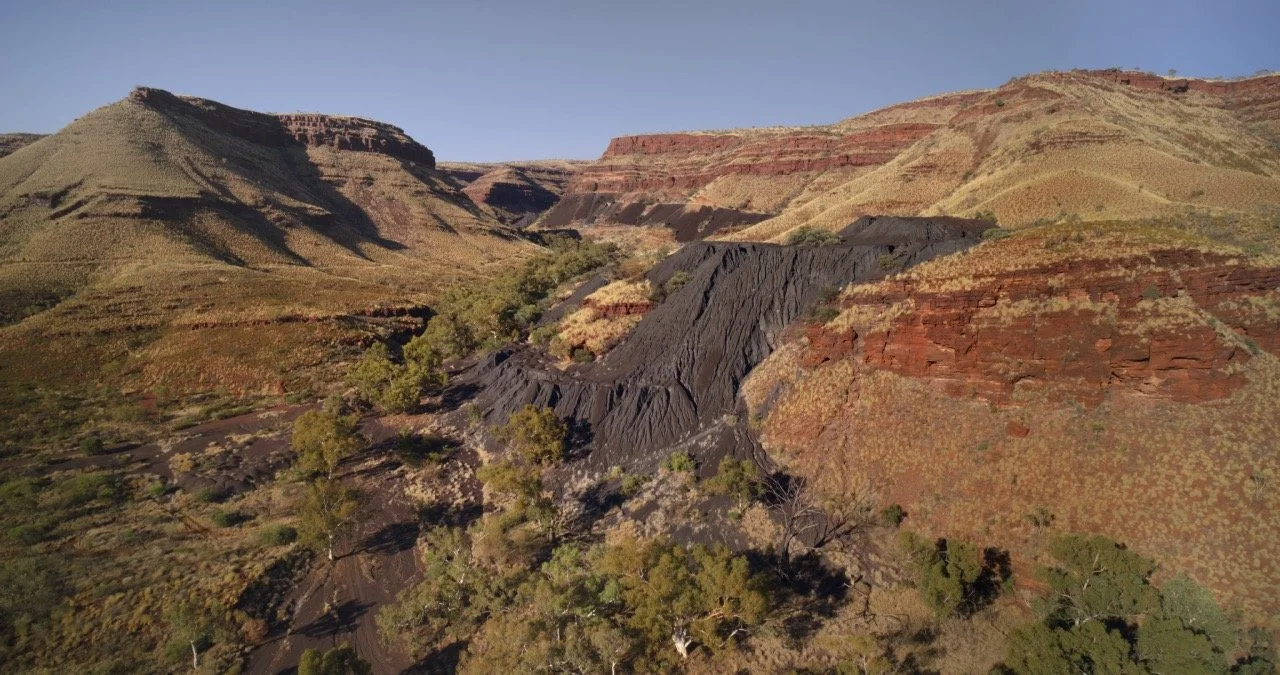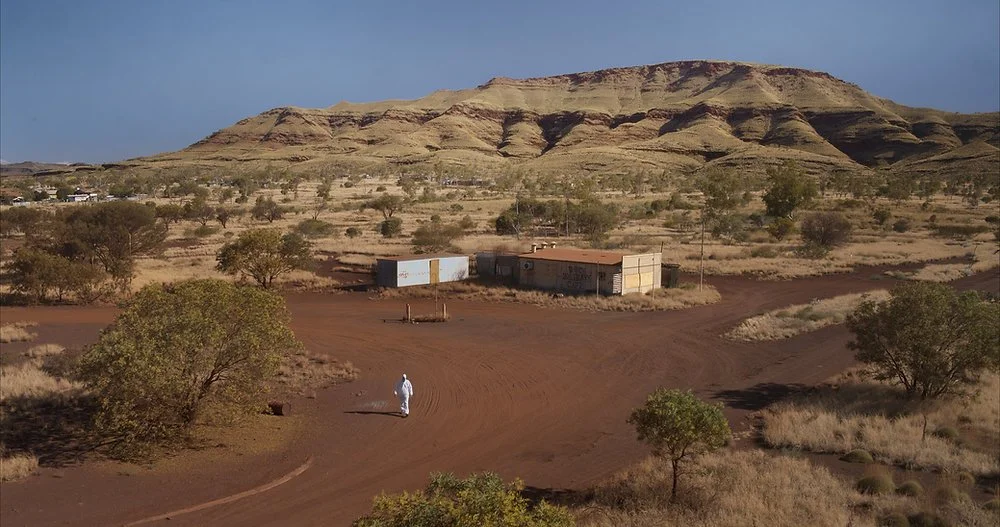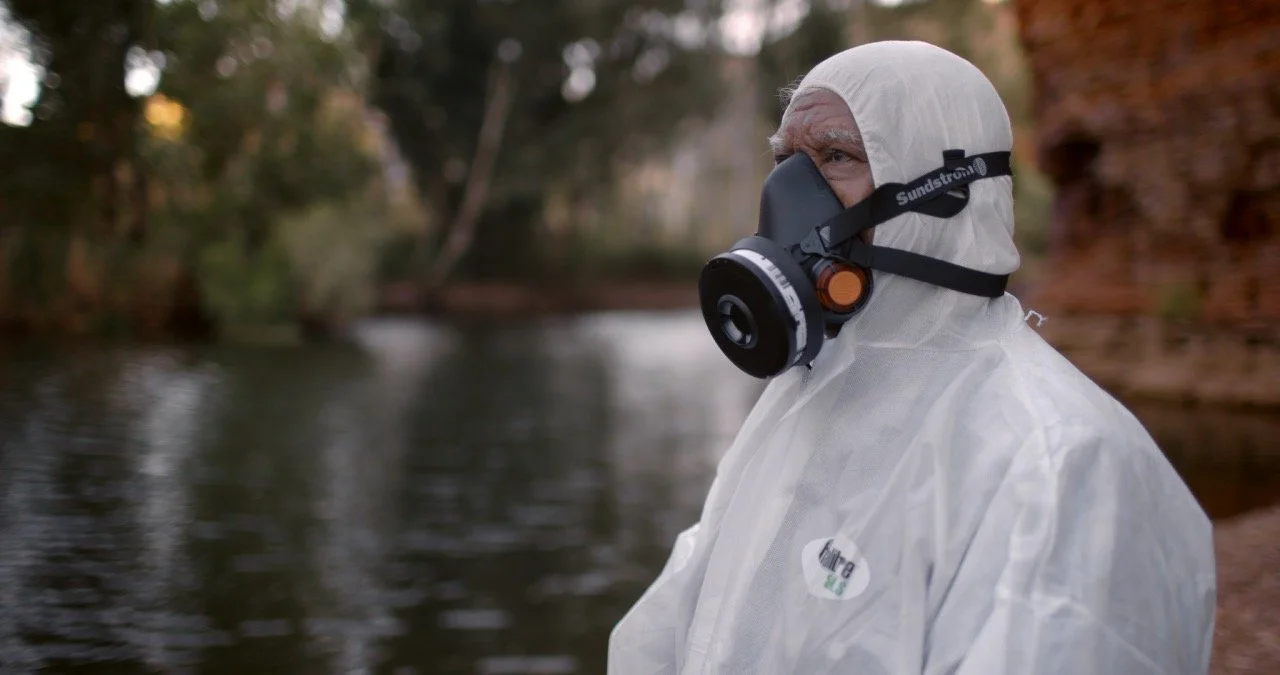A Filmmaker’s “Slow” Lens on Country: Banjima Elder Breaks Tradition to Protect Pilbara Land
Published by The Biophilic Blueprint | Written by Anjelica Smilovitis, Founder
Cultural Warning Aboriginal and Torres Strait Islander readers are respectfully advised that this article contains the names of people who have passed away. We acknowledge and honour their memory, and recognise the importance of cultural protocols when sharing their stories.
Banjima Elder, the late Maitland Parker and Yaara Bou Melhem before they head into the contamination zone on Yurlu-Country. Photo: Illuminate Films.
To tell a story like Yurlu is to slow down — to step away from the rush and sometimes ‘extraction’ of fast media to listen and attune to Country.
Yurlu / Country is a documentary film born from a profound act of courage, following Banjima Elder Maitland Parker during the final year of his life as he fights to heal a land poisoned by Wittenoom asbestos mining.
When director and filmmaker Yaara Bou Melhem began documenting Yurlu / Country with co-writer Maitland Parker, she recognised immediately that this was not a film that could be shaped at the hurried rhythm of modern media. It would only flatten the depth of what Maitland carried.
The Biophilic Blueprint spoke with Bou Melhem about documenting Yurlu / Country alongside Maitland—exploring his “break from tradition” in sharing his story so openly, and the delicate work of filming with his family as he moved through illness. Maitland passed away in January 2024.
In our conversation, one theme aligned closely with the ethos of The Biophilic Blueprint: the necessity of slow media.
In speaking with Bou Melhem, we saw something deeper: a commitment to slow media. Her filmmaking resists the noise and extraction of modern reporting, moving instead at the pace of Country—patient, attentive, grounded in relationship. In a media landscape driven by urgency and algorithms, her approach feels more like ecology than industry, shaped by listening and reciprocity.
The film’s focus is deeply human: Maitland’s fight for his community, family and Country comes from a place anyone can understand—love.
“This documentary is about a man who loves his family, who loves his community, who loves his land, and that's something that we can all relate to. He was fighting for the health of himself, of his family, his community and the health of his land,” she said.
Maitland personified the idea that restoring and remediating our environments is intrinsically linked to our own health and wellbeing.
That instinct, she explains, speaks to a broader truth: “There's this growing awareness or realisation that ecological health and the health in our home is linked to our own health. We can’t swim in many wild rivers anymore because of pollution. We have dedicated zones of parks that we can go and walk in—but we should be able to expect a clean environment everywhere.”
Wittenoom asbestos mining left the largest contaminated area in the Southern Hemisphere, located on Maitland’s homeland—Banjima Country—in the Pilbara’s red gorge systems of Western Australia.
Yet the erasure of Wittenoom town and its signage has left a story untold—out of sight for many, yet painfully present for Banjima people.
Wittenoom is the largest contaminated site in the Southern Hemisphere, Yurlu / Country. Photo: Illuminate Films.
Yurlu documents this erasure while reclaiming the historical narrative, centring the voices of the Banjima—the Native Title holders—long sidelined in accounts of the disaster zone.
Through archival footage and historical records, the film exposes the mid-century colonial mindset that drove the “opening up” of the north-west: a vision of progress that justified mining expansion while ignoring both human and environmental costs.
The film follows Maitland as he confronts government inaction and the long shadow of corporate harm, navigating the deep cultural scars left by Wittenoom—all while allowing his final year, and its most private moments, to be recorded.
Storytelling in rhythm with Country
Bou Melhem told The Biophilic Blueprint when she first came across Maitland’s story, she was making a different film about the 60,000 abandoned mines that are scattered across Australia, many of which have environmental and health legacies.
“At first his story was going to be one of many communities that are affected by this issue, but we went out and filmed with Maitland first because he had a terminal illness, and when we met him and started spending time with him, and saw that he wanted to tell a story with us, it soon became clear that the documentary had to pivot and have the singular focus of following Maitland and his fight,” she said.
The film team with Maitland Parker at Karijini National Park, Yurlu / Country. Photo: Illuminate Films.
While Bou Melhem initially considered returning to a broader investigation of Australia’s 60,000 abandoned mines, she quickly realised that the story could not sit in the past tense. The so-called “legacy sites” are still shaping lives, health and Country in real time.
“It would be a mistake to frame this as a legacy issue rather than a live current issue. There are some live current issues that are connected to the legacy sites that you can bring that information about the legacy sites into, but the focus and the framing really needs to be about the current issues.”
“A lot of people didn’t understand or know that this was a live issue.”
“It is such a human story, and so relatable, that people came out of the film almost shell-shocked—by the enormity of the issue, how it has impacted people, how it continues to impact them, and how it has affected someone like Maitland and his family, who audiences can truly relate to.”
Slowing down the narrative with filmmaking
Bou Melhem’s path to Yurlu was shaped by years of investigative reporting—and a motivation to craft stories that invite people to reflect, feel and ultimately take social action for the greater good.
“I got into this professional industry because I love storytelling, but I also love telling stories that have a social purpose. I'm quite civic-minded, but my interest is in the craft of storytelling and narratives, and so I was drawn to journalism and filmmaking from the outset.”
Before turning to filmmaking, she spent 15 years reporting for SBS Dateline and Al Jazeera English, and filing stories for ABC’s Foreign Correspondent — and during that time, she began noticing a widening gap in how audiences were absorbing information.
“I was a foreign correspondent for a very long time, and then I moved into filmmaking just after the advent of social media. I grew up as a journalist as social media platforms started coming online and changing the way that we consume information and media, and I noticed that facts weren't translating anymore. It wasn't enough to put out information to people, to just present the facts to them, without some sort of follow-through or some way people can process that information and translate that into social good.”
Filmmaking became her way to slow down the narrative, creating space for audiences to fully experience a story. Her films are not campaigning, but they are deeply purpose-driven.
“Film is this place that invites people to experience another world and immerse themselves in another person's life. There's something quite special about film, especially if you're watching it in a cinema, which is quite antiquated these days with streaming.
“When you bring people into a cinema and ask them to put away their phones for 90 minutes to watch a film, they're having this shared experience with other people. They're not distracted. They're there with a purpose to watch the film, and you're inviting them into this space where they can feel something.
“I invite you through my films to come to a particular position, or to have existing status quo positions challenged by what you're seeing. That's the power of filmmaking. And that's why I moved into it, especially at this time when everything is quite algorithmic-focused and outrage-driven on social media—it's good to have places that just invite you to sit back, relax and then think, and then perhaps act, if that's something that you're compelled to do.
“This is what I try to do with my films. I try to invite people to feel what the facts are, rather than tell them what the facts are. It's kind of like the classical ‘show, don't tell’ mantra that we try to pursue in filmmaking and in the early days of journalism."
“That's quite refreshing in this environment where our information ecosystems are fragmented. They're toxic. People are kind of yelling down the barrel of their phones into this algorithmic void that is just feeding outrage,” Bou Melhem explains.
Western Australia has the highest mesothelioma rate in the world. Photo: Clean up Wittenoom.
A break with tradition to care for Country
This patient, deliberate approach to filmmaking mirrored the process of documenting Maitland’s life, which demanded sensitivity and profound respect for Indigenous customs. “It's incredibly difficult as a non-Indigenous filmmaker to be working with Indigenous subject matter, so we just moved very slowly,” Bou Melhem says.
“He's (Maitland) a senior traditional law man, a very cultural man, and in many Aboriginal communities, it's taboo to speak about illnesses, to speak out about it publicly. He broke with tradition, not only to speak out about his illness, but to allow us, as the filmmakers, to follow him during some of the most intimate and private moments of anyone's life, let alone an Indigenous Elder, as this kind of death sentence of mesothelioma took its course.”
Maitland allowed Bou Melhem and her team to use his name, voice and image even after his passing.
“It is, again, a break with tradition. He wanted his story to come out, and he said that his story had power, and he wanted his people to use it to advocate for a cleanup of their Country.”
Bou Melhem relocated from the East Coast to Perth during filming. “We moved with our entire family and spent time with his family during that period, only picking up the camera at their request a couple of times.”
“Sometimes we just were there without picking up the camera. We spent quite a bit of time with Maitland’s family during Sorry Business. The family knew that he wanted them to help us finish the film, but they were also grieving. We had to keep that in the back of our mind for everything and make sure we respected that time and process, and respect they would come to us when they were ready to finish what he started.”
Maitland’s personal exposure to the asbestos contamination was indirect. “He didn't work in the mines. He was living as a national park ranger in Karijini National Park, which is adjacent to the contamination zone, and his exposure to this asbestos came from living near it, and he developed mesothelioma, which is an aggressive cancer that you can only get from asbestos exposure, as a result of this.”
“It is Australia's Chernobyl,” says Bou Melhem. “There's 3 million plus tonnes of asbestos waste that have been left behind by the Wittenoom asbestos mines. They closed 60 years ago, but this problem is ongoing. The contamination zone is about eight times the size of Manhattan, and the contamination is now spreading outside the contamination zone.”
Between 1937 and 1966, asbestos miners deposited more than three million tonnes of mine waste—known as “tailings”—laced with deadly blue asbestos across the Wittenoom region.
While Bou Melhem initially considered returning to a broader investigation of Australia’s 60,000 abandoned mines, she quickly realised that the story could not sit in the past tense. The so-called “legacy sites” are still shaping lives, health and Country in real time.
“It would be a mistake to frame this as a legacy issue rather than a live current issue. There are some live current issues that are connected to the legacy sites that you can bring that information about the legacy sites into, but the focus and the framing really needs to be about the current issues.”
“A lot of people didn’t understand or know that this was a live issue.”
“It is such a human story, and so relatable, that people came out of the film almost shell-shocked—by the enormity of the issue, how it has impacted people, how it continues to impact them, and how it has affected someone like Maitland and his family, who audiences can truly relate to.”
Banjima Elder Maitland Parker.
Erased from sight but not from mind
Yurlu documents the erasure of Wittenoom, the town tied to the asbestos mines. Yet the contamination at Ngambigunha, Wittenoom, on Banjima Country in the Pilbara continues to cause illness, cultural disconnection and environmental devastation—effects that will worsen without intervention.
The film not only traces the impact of the mine but also highlights why restoring and remediating the site is essential to safeguarding Country for future generations, supported by the impact campaign #CleanUpWittenoom.
“The government, whether deliberate or not, has engaged in a process of erasure with regards to Wittenoom. It was erased from maps in 2007, degazetted, and the name Wittenoom was removed from road signs. The town itself—attached to the asbestos mines—was razed to the ground and buried, because that's the only way to deal with asbestos waste.”
“What we're trying to do with this film is bring this out-of-sight, out-of-mind problem into full view.
“It's not out of sight and out of mind for Banjima people. Aboriginal people in Western Australia have the highest death rates from mesothelioma in the world, and there isn't one Banjima family that hasn't been touched by this issue. What we're trying to do is bring it into full view for the rest of us,” Bou Melhem tells The Biophilic Blueprint.
Despite repeated government inquiries over the past 30 years, which even described the site as “environmental vandalism,” meaningful remediation has yet to occur. In 2008, authorities formally restricted access to the Wittenoom Asbestos Management Area, a 46,840-hectare exclusion zone—effectively a modern-day sacrifice zone.
“In order to heal Country, they need to be able to access it, and they can't access it safely. So, this is a place they cannot connect with safely anymore,” Bou Melhem said.
“What we do have in the film in relation to what the government has done so far is look at a series of reports they've commissioned which look at remediation options. The last one for Wittenoom and the contamination was commissioned in 2015 and said it would cost approximately $150 million to contain some of the main sites of contamination. And nothing has been done.”
“There were successive parliamentary inquiries that recommended a cleanup of the site, and nothing was done. The engineers who commissioned some of those remediation reports said that if you don't do anything to stabilise these tailings dumps—basically mining waste—these major sites of contamination will continue to spread, and I quote here, for hundreds of years. And this is what's happening.”
“And now we have contamination spreading outside the continuation zone.
Following this interview, in November WA Premier Roger Cook provided the clearest signal yet from any government that action could be taken to contain Wittenoom’s asbestos tailings and prevent further environmental spread.
His statement comes amid mounting pressure from Traditional Owners to remediate the deadly asbestos deposits in Wittenoom and Yampire Gorges in the Pilbara, which have remained uncontained for nearly six decades.
“Banjima have engaged some lawyers now to help them with their strategic litigation to remediate Country, and they're looking into some of the world's best-practice technologies that can be deployed to clean up the area. At the very minimum, stabilising these major sites of contamination—so they don't continue to spread—is critical,” Bou Melhem tells The Biophilic Blueprint.
Senior Banjima Elders Trevor and Maitland Parker at Peedamulla Station, Yurlu / Country. Photo: Illuminate Films
Slow Media Approach aligns with The Biophilic Blueprint
Bou Melhem’s work reflects what The Biophilic Blueprint champions: a slower, more deliberate form of storytelling that honours people, culture and Country. In a media ecosystem dominated by outrage and fleeting attention, Yurlu / Country demonstrates that real change can be sparked by patience, empathy and careful listening. In showing Maitland’s courage, Bou Melhem invites audiences to connect, reflect and act — not as spectators, but as participants in the ongoing care of Country. And in that slow, attentive space, media becomes more than information: it becomes a bridge between people, land and the possibility of healing.
Comment below: What value do you see in slowing down the pace of media—how might it change the way we understand the world?
References and further reading
Yurlu / Country screens in cinemas nationwide from November 13. For screening times and locations, visit yurlucountry.com/screenings
Zaunmayr, T. (2025, October 31). Roger Cook says govt ‘has to act’ on Wittenoom asbestos fix. Business News. https://www.businessnews.com.au/article/Roger-Cook-says-govt-has-to-act-on-Wittenoom-asbestos-fix
The Biophilic Blueprint supports efforts to restore Country and invites readers to take action. To learn more or pledge your support for the clean-up of Wittenoom, visit cleanupwittenoom.com/pledge





